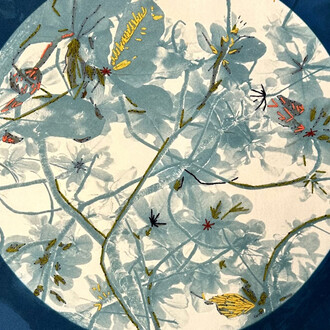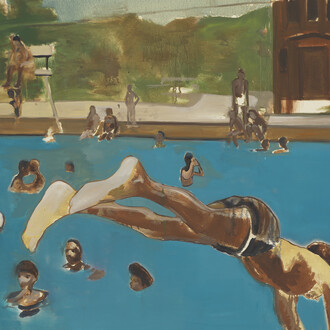kurimanzutto and Luhring Augustine are delighted to announce a major two-part exhibition of works by the late Mexican artist Julio Galán. Marking the first significant solo presentation of Galán’s work in New York in over two decades, the show will be held simultaneously at both galleries’ Chelsea locations from March 6 through April 19, 2025.
Galán’s brilliant career, which spanned from the mid-1980s until his untimely death in 2006, was primarily centered in New York City, Paris, and Monterrey, Mexico. While his work has not been broadly exhibited outside of his native country since his passing, his work was exhibited internationally extensively during his life, and he is widely considered the preeminent Mexican painter of his generation. Galán’s nonconformist and expansive multidisciplinary practice addresses issues of identity, gender, culture, and social constructs in works that layer self-representation and aspects of the personal with larger themes of cultural and sexual difference. Infused with an allegorical quality and woven throughout with a complex array of signifiers—enigmatic iconography and cultural references—his works, as well as his carefully crafted public persona, embraced a self-conscious othering and an ambiguous mutability that refused fixed interpretation. As art historian and professor Teresa Eckmann writes, “On canvas, he recounted and constructed illogical visions, teasing out the line between the real and artifice, his artwork deemed an “inaccessible yet formally intoxicating fabrication of self.”1 Galán hid from the viewer his artwork’s content as much as he revealed it; simultaneously, with his body, he explored fluid identity through masquerade.”2
Rendered in a pastiche of styles, with a syncretic approach to culture, Galán’s work blends references and influences from Mexican folk and religious imagery to Surrealism, Pop Art, and graffiti. While he has often been associated with the Neomexicanismo movement of his native country and the Neo-expressionism of his peers in New York, these were characterizations he resisted, much in the way that he deliberately rejected any form of restrictive definition or singular interpretation. Magalí Arriola, former director of Museo Tamayo and curator of Galán’s most recent major retrospective, notes, “Though in some of his work [he] resorted to an iconography associated with popular Mexican culture…the use of stereotypical figures such as the charro of the Tehuana, was also related to his interest in transvestism and disguises as strategies to subvert sexual identities and other cultural constructs.”3 Galán’s approach exposes the limitations and issues inherent in the interrelated sentiments and systems that create and uphold any form of binary classification or fixed characterization, be they related to sexuality, nationality, spirituality, or any categorization. As writer Evan Moffitt notes, “Galán’s adoption of Mexican stereotypes and Platonic personalities reveals nationalism to be a kind of pompous drag…. There’s plenty of kitsch in Galán’s paintings, to be sure, but that kitsch is fundamental to their radicalism.”4 Continuing to resonate today are the remarkable energy, intelligence, and theatricality of Galán’s work, and the questions he explored regarding the relationship of individual identity and the creation of the self to oversignified notions of culture and nationalism.
Notes
1 Galán, Julio. Artforum international, October 1990, 169.
2 Eckmann, Teresa. Julio Galán: The art of performative transgression, 5. Albuquerque: University of New Mexico Press, 2024.
3 Arriola, Magalí. “Red and Green Can Also be Something Else,” Julio Galan: A rabbit split in half, 102. Mexico City: Editorial RM, 2023.
4 Moffitt, Evan. Confessions of a mask, 2025, 4-5.




















